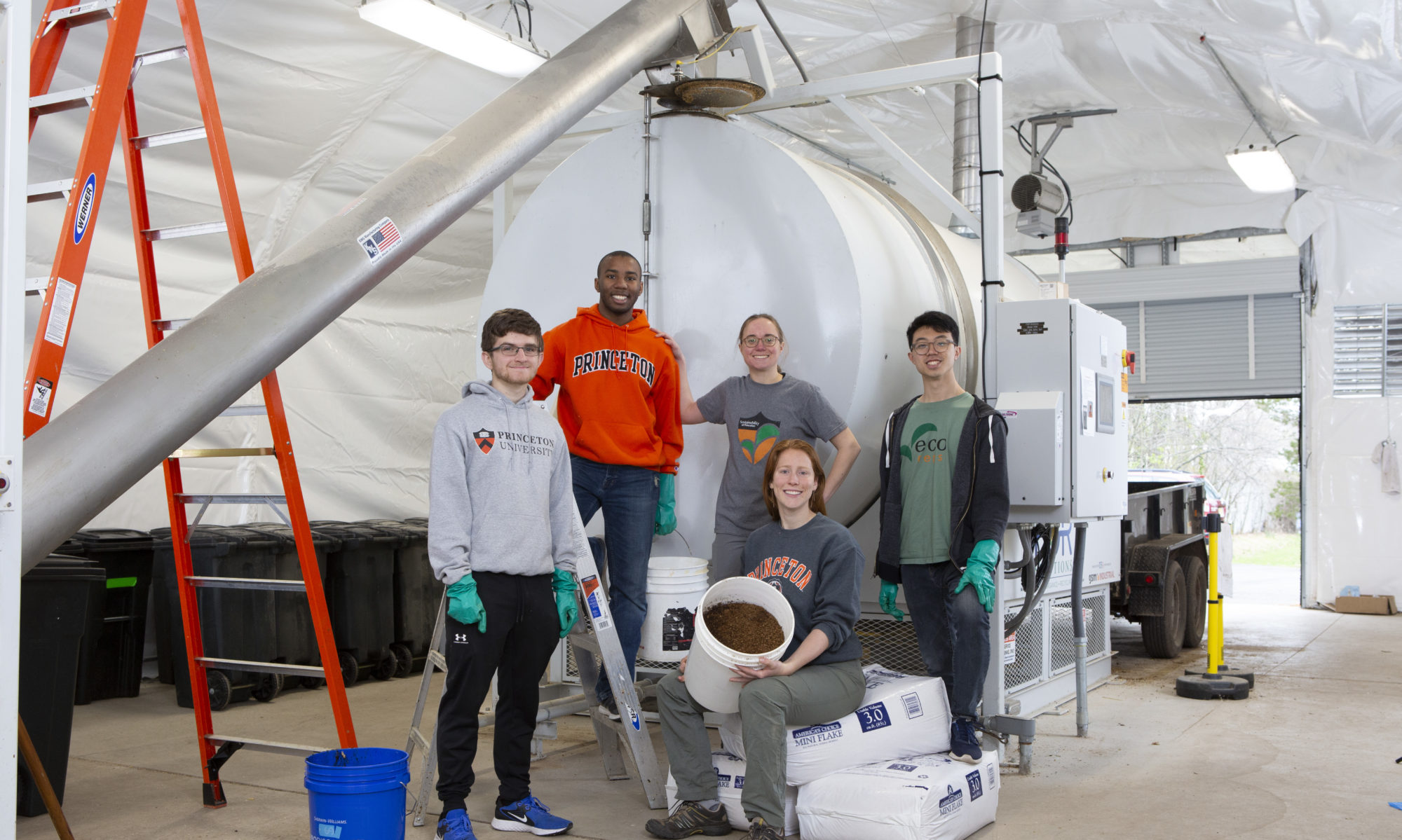Our faculty Q&A series wraps up with an update from Professor Xinning Zhang, an environmental microbiologist jointly appointed in the Department of Geosciences and the High Meadows Environmental Institute. This month, the ComPOSTer interviewed Dr. Zhang to learn more about how her lab is extending its research in microbial metabolism and biogeochemcical cycling on the Princeton campus, and how it relates to environmental justice.

What are the main questions that your research group is asking about the composting process and how is the S.C.R.A.P. lab involved?
The Zhang lab is broadly interested in understanding the role of microbes in decomposition and greenhouse gas cycling within man-made and natural environments. As the environmental and human health harms of using industrial fertilizers to promote plant growth have become clear, many communities, including the University and the township, are exploring compost as a nutrient rich amendment to soils in place of industrial fertilizers.
Working with the S.C.R.A.P. lab, members of the Zhang group (Gabrielle D’Arcangelo ’21, Galen Cadley ’21, Dr. Jared Wilmoth) have been studying the microbial decomposition of food and garden waste into compost and greenhouse gases like carbon dioxide and methane with the aim of optimizing Princeton University’s aerobic digester for producing nutrient rich compost with low net greenhouse gas emissions. Specifically, we would like to determine (a) who the main microbial actors are in the compositing process, (b) how these microbes work together to make healthy compost, and (c) how microbes and their activities respond to changes in the composition of incoming food waste flows and environmental characteristics like aeration levels and temperature.

What have been the preliminary findings to-date and the next steps in the research?
While there is insufficient sample consistency to make any firm conclusions, preliminary findings of the microbial community analysis have identified Lactobacillus and Acetobacter to be the most dominant bacterial groups (indicating a rapid uptake of simple sugars), followed by Clostridium and Chitonophaga (complex carbon degradation), and less than 1% of methane-producing organisms, the most dominant being the oxygen-intolerant hydrogen gas consumer, Methanobacterium.
An accumulation of the latter category or “methanogens” was found during a power outage and when on-loading/off-loading of material was halted. These results indicate that to avoid increased methane emissions, compost materials should not be allowed to sit for long durations (> a couple days) in the composter, particularly in the back end of the unit where oxygen-free conditions favoring microbial methane production easily develop.
Future work will aim at evaluating whether increases in aeration frequency and/or changes in food waste/bulking agent composition will further reduce composter methane levels. However it is important to note that even optimally working municipal waste composts can contain anaerobic pockets allowing the presence of about 1% methane-producing bacterial species, so these results are consistent with those found in other composting operations.
Why is this research important and how does it relate to environmental justice?
The application of industrial fertilizers leads to numerous environmental problems, most notably the eutrophication of water supplies with detrimental effects on water quality, fisheries health, and greenhouse gas emissions. Unfortunately, these environmental harms are disproportionately borne by people of color in lower income neighborhoods. We hope that our work with the S.C.R.A.P. lab on the science behind composting will aid in weaning our food and landscaping system off industrial fertilizers to promote environmental health and justice.
Interview edited for length and clarity

It’s really exciting to see attention paid to methane and nitrous oxide emissions from composting, and finding ways to minimize those GHGs. Have you also looked at ammonia emissions? As a Princeton alum who subsequently pursued a masters degree in agronomy and soil fertility management, I have to offer a correction: compost is not a direct replacement for synthetic fertilizer. Compost contains very little nitrogen, and a grower who wants to avoid synthetic N can’t do that with compost alone. You need to either rotate in leguminous crops/cover crops or apply other high-N fertilizers. If you try to meet your crop N needs with compost alone, you’ll build up excess soil phosphorus which will cause runoff/eutrophication problems.
Eutrophication is not a problem unique to industrial fertilizers. It results from any poorly managed nutrient source, including livestock manure, compost, septic systems, and wastewater treatment plants. The nutrients polluting the Chesapeake Bay come largely from poorly managed livestock manures. Proper fertilizer management is required to prevent nutrient pollution, no matter what kind of fertilizer you are using, organic or synthetic. Perhaps it’s worth reaching out and building some connections with the soil and nutrient management departments at Rutgers!
Dear Bradley,
Thanks for following the blog and apologizes for the delayed response. I appreciate your clarifying comments about compost nitrogen availability and synthetic fertilizers. Indeed, organic amendments such as compost and livestock manure can also be sources of nitrogen that lead to eutrophication and can volatilize into nitrous oxide (N2O) whether directly from the soil or indirectly from bodies of water after surface runoff or leaching. However I do want to note that synthetic fertilizers are the largest contributor. In the EPA’s most recent “Inventory of U.S. Greenhouse Gas Emissions and Sinks” report, industrial fertilizers produced more N20 emissions compared to organic amendments in 2019 at least in the entire US (See the breakdown in Table 5-18 for direct N2O emissions. The source breakdown was not available for indirect emissions from surface runoff, but those emissions are small compared to the direct emissions, so even if they are credited to organic amendments, the emissions from synthetic fertilizers would still be higher. However, the relative breakdown will be different depending on region like you mentioned for the Chesapeake Bay).
We hope to restart this research this academic year, but on this point, I agree it would be interesting to also measure ammonia which can turn into the greenhouse gas, nitrous oxide.